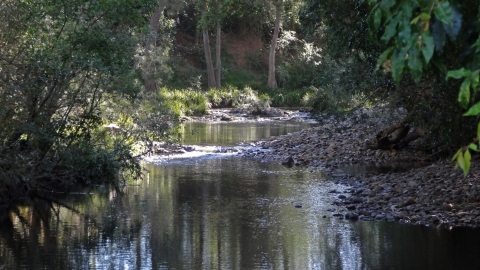- Home
- Assessments
- Bioregional Assessment Program
- Methods
- Assigning receptors to water-dependent assets
- 3 Assigning receptors
- 3.3 Process for assigning receptors across the landscape
The process for assigning receptors in a BA is iterative in nature and needs to include input from across the Assessment team (Figure 4). The main steps in the process include the following, noting that while steps one and six are the subject of this submethodology they depend on the other steps, which are the subject of other submethodologies:
- Select appropriate receptor locations to provide a preliminary coverage of the assets and landscape classes (see Section 3.3.2). This will produce a preliminary (draft) receptor register.
- Commence hydrological response model development and runs (refer to submethodologies M06 and M07 as listed in Table 1) based on the BA's conceptual modelling (refer to product 2.3 (conceptual modelling) and submethodology M05 as listed in Table 1).
- Conduct sensitivity analysis of model output (refer to product 2.6.1 (surface water numerical modelling) and product 2.6.2 (groundwater numerical modelling) and submethodology M09 as listed in Table 1).
- Examine model output to identify regions where there are detectable changes in hydrological response variables in relation to the CRDP (refer to product 2.6.1 (surface water numerical modelling) and product 2.6.2 (groundwater numerical modelling) and submethodologies M06 and M07 as listed in Table 1) and to define the potential spatial extent of hydrological responses.
- Identify key hydrological response metrics representative of the assets and landscape classes within the regions where there are detectable changes in hydrological response variables (refer to submethodologies M08, M09 and M10 as listed in Table 1).
- Refine the selection of appropriate receptor locations to provide coverage of the assets and landscape classes in a representative, efficient and complete manner that is fit for purpose and in accord with high standards of professional scientific practice (see Section 3.3.2 and Section 3.3.3). This will produce the final, refined receptor register.
- Build model emulators that summarise the key hydrological responses and specific points in time (refer to submethodologies M09 and M10 as listed in Table 1).
- Build appropriate sets of rules to interpolate the outputs of the model emulators (i.e. outputs at receptors) to all of the assets within the subregion or bioregion (i.e. develop the summary metrics that provide complete coverage of assets) (refer to submethodologies M08 and M10 as listed in Table 1).
Step five in this procedure is the major point of focus for the entire assessment. The process of identifying areas within the PAE where changes in hydrological response variables are detectable will (in most cases) reduce the spatial extent of the assessment. This step can act to concentrate the statistical emulators associated with the uncertainty analysis into areas where there are non-negligible changes in nominated hydrological response variables, but also provides the opportunity to examine in more detail conceptual models for assets in the location of hydrological impact and ensure that hydrological response variables are representative of potential impacts. This will assist the refinement of the receptor locations.

METHODOLOGY FINALISATION DATE
- 1 Background and context
- 2 Defining receptors
- 3 Assigning receptors
- 3.1 Overview of process for assigning receptors
- 3.2 Landscape classification
- 3.3 Process for assigning receptors across the landscape
- 4 Developing a receptor register
- References
- Datasets
- Glossary
- Citation
- Acknowledgements
- Contributors to the Technical Programme
- About this submethodology
